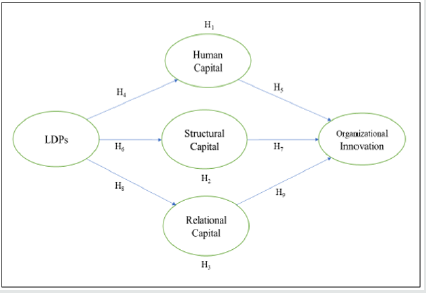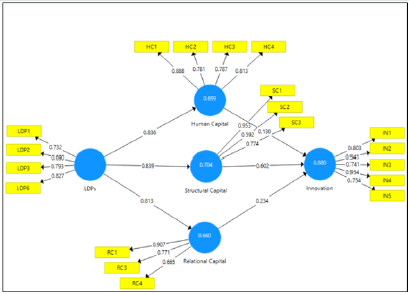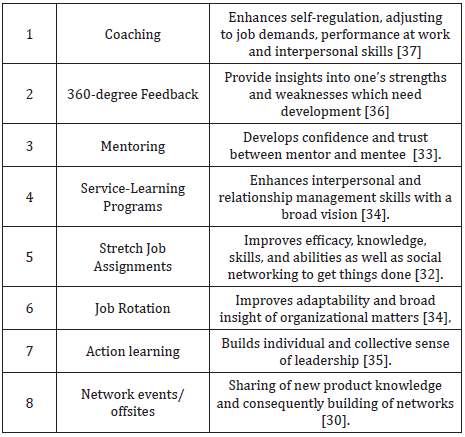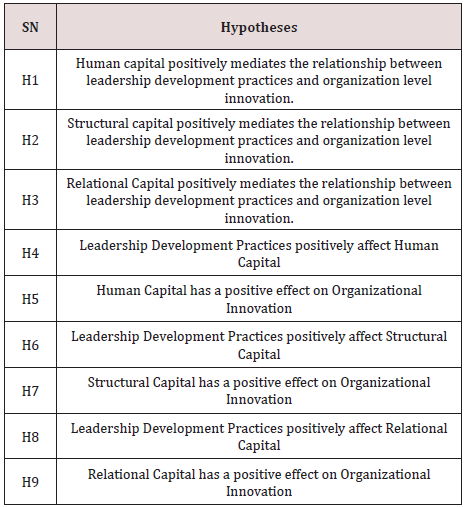
Lupine Publishers Group
Lupine Publishers
Menu
ISSN: 2637-4595
Research Article(ISSN: 2637-4595) 
Leadership Development Practices and Organizational Innovation: A Mediation Analysis of Readymade Garments Industry Volume 3 - Issue 4
Farheen Shafi* and Kamran Yousaf Sandhu
- Department of Business Studies, National College of Business Administration and Economics, Pakistan
Received: February 18, 2021 Published: February 26, 2021
*Corresponding author: Farheen Shafi, Department of Business Studies, National College of Business Administration and Economics, Lahore, Pakistan
DOI: 10.32474/LTTFD.2021.03.000170
Abstract
Purpose: This exploratory research was intended to examine the mediating role of the intellectual capital (IC) dimensions, i.e., human capital (HC), structural capital (SC) and relational capital (RC) in RMG industry Lahore, Pakistan.
Design/Methodology: Based on convenience sampling technique 250 questionnaires, including 22 items, were distributed among the industry experts. Data was collected from 200 respondents. Smart PLS 3 software was used for conducting analysis such as regression, internal consistency and mediation tests. Reliability and validity were checked and verified.
Findings: Two out of the three hypotheses showed significant results. HC and SC positively mediated the relationship between leadership development practices (LDPs) and organizational Innovation (OI) while RC does not. Structural capital more strongly mediates this effect on (OI) as compared to (HC).
Implications: This study will aid RMG industry in comprehending the antecedents of innovation for competitive advantage. The industry is in dire need of identifying the IC component which greatly leverages the influence of LDPs on (OI). The RMG industry now need to focus on (SC) and (HC) and must design relevant practices for the development of leaders which congruently affects structures, process and technological infrastructures.
Originality/Value: Extant literature focuses on leadership development practices with innovation outcomes at individual and organizational level. However, which component of intellectual capital better mediates the relationship in RMG industry of Lahore, Pakistan, has rarely been explored. This novel research model examines the effect of specific leadership development practices on individual dimensions of intellectual capital and organization level innovation. The importance of leadership development practices for innovation cannot be over-emphasized as these practices not only build interpersonal and intrapersonal skills of leaders but economically enable the individual firms and industry in achieving competitive advantage in the international markets.
Keywords: Leadership development practices; training and development; human capital; structural capital; relational capital; organizational innovation
Introduction
To lead, manage and excel in work as a manager, one needs to think uniquely about latest challenges faced by the organization and the people. Human capital with all its strengths and potentials still needs an agile, trusted, and dynamic role model. An innovative leader needs to learn how to create a conducive innovative work climate where new ideas generate and get implemented with guided modifications. Innovation cannot be ensured only by hiring a few creative professionals but in fact the organizational culture need complete overhauling. Organizational culture is manifest of leadership competencies. Therefore, more focus is required on developing leaders at all levels through specific trainings and assignments. Leaders thus trained influence the subordinates through team effectiveness, effective and quick decision-making, change management, exploring new markets and product and process research and development. How leaders orchestrate human capital and other resources for organizational outcomes is a function of leader’s development. The two dimensions of LDPs as discussed by [1] intrapersonal (cognitive and behavioral skills learned from experience and mastery) and interpersonal development (relationships, extended social networks building) have significant impact on two dimensions of intellectual capital i.e., human capital and social capital. The research findings of a similar study by [2] confirmed the mediating effect of human capital but not of social capital to organizational outcome of sales growth. The study combined the relational and structural capital to form social capital whereas separate assessment of structural capital and relational capital is important in terms of organizational innovation especially in RMG industry. To address this gap the prevailing most common and effective leadership development practices on individual level were selected. Their implementation at organizational level was observed on intellectual capital dimensions like human capital, social capital, and relational capital and subsequently on innovation. Empirical data was collected from 250 senior level employees of 30 RMG factories operating in Pakistan, a fast-growing economy. A combination and complementarity of these practices enhances the impact as well as buffers against failure of any one practice on an individual [3].
Problem statement
The ready-made garments industry of Pakistan is faced with multi-faceted issues including high cost of production, less skilled human capital at the firm level, and bureaucratic hurdles in about twenty government departments hindering its growth. Weaknesses in human capital and internal structures obstructs market and product diversification, desperately required to stay competitive in global market. The export competition has strengthened in the last decade or so. To meet the challenges of international market and avail upcoming global opportunities the industry needs to build and mobilize its resources in an optimum manner. This requires dynamic leadership and associated training and development practices which could enable a leader to harness and utilize all factors of production in the right direction. This study intended to identify a component of intellectual capital which most strongly mediates the relationship between leadership development practices and innovation in RMG sector. This would give direction to policy maker in devising specific and effective practices for leadership development.
Objectives
The objective of this research is to examine and compare the strengths of mediation of human capital, structural capital, and relational capital in the relationship between LDPs and organizational innovation. In order to prevent depletion of human capital, investment in hiring, training and development is imperative. Structures as processes lead to cost effectiveness and efficiency. Relational capital keeps a firm ready to respond to changing demands, ensures ease of doing business through social networking and considerations. Moreover, leadership development practices enable the leaders to bring to surface the potentials of various dimensions of intellectual capital for sustained competitive advantage. An agile leader can create a conducive environment for nurturing innovative behavior in employees leading to organization level innovation. For this purpose, the RMG Industry need to identify which dimension of intangible capital to focus on in order to leverage the effect of leadership development practices on innovation.
Research questions
a) To what extent can HC mediate the relationship between
LDPs and Organizational Innovation?
b) To what extent can SC mediate the relationship between
LDPs and Organizational Innovation?
c) To what extent can RC mediate the relationship between
LDPs and Organizational Innovation?
Literature Review and Hypotheses
The strategic aspect related to LDPs has urged researchers to establish the significance of LDPs on innovation of firms. The human capital skills knowledge and abilities must be developed and aligned to organizational objectives. The resource-based view was based on competitive heterogeneity, a notion of acquiring and developing valuable, limited, and unique resources to gain competitive edge via strategic actions [4]. Extant literature acknowledges the central role of human capital as the basis of competitive edge as to capacity building of the organization [5]. Leadership development or HR practices influence organizational performance outcome by improving skills and competencies of the employees. Numerous studies have investigated the mediating role of various constructs like productivity [6], social climate [7], knowledge management, [8]. This study intends to explore the mediating role of three dimensions of intellectual capital to conclude which dimension most effectively influences innovation as a resulting effect of LDPs (Figure 1).
Human capital
In a meta-analysis [9] of 68 studies indicated a positive relation between human capital and organizational performance like sales growth. This is because human capital acts as a coordinating force to harness all other resources (Table 1). When tangible resources can be readily acquired from market, human capital gives organization a competitive edge by building up over time. Leadership competency building leads to exceptionally performing human capital. Thus, based on this logic we propose that: Hypothesis 1: Human capital positively mediates the relationship between leadership development practices and organization level innovation (Figure 2).
Structural capital
Structural capital comprises of process capital and innovation capital [10]. Process capital facilitates and supports the workforce in enhancing productivity [11] and demonstrating a high level of intellectual performance on one hand and maintaining market share and product quality while innovation capital is based on knowledge sharing culture. In a study [12] structural capital positively affects firm’s performance in the service industry and new business growth [13]. An employee with high intellect can seldom demonstrate optimum potential when systems and procedures are not up to the mark. Only supportive structural capital can tolerate individual learning by trial and error vital to success. Intellectual capital can only be measured in the presence of structural capital (Table 2). The elements of cost benefit comparisons, reducing costs and maximizing profits, increasing efficiency, and reducing transaction time and converting information to knowledge all resides in structures. Moreover, research and development expenditure being a main determinant of innovativeness, ensures firm’s sustained competitive edge. A research study [14] observed 89 companies in the last two decades of twentieth century and found that 1 dollar of expenditure on research and development almost promises 2 dollars of profit after a decade. This discussion brings us to hypothesize the following: Hypothesis 2: Structural capital positively mediates the relationship between leadership development practices and organization level innovation.
Relational capital
Relational capital is manifested in the myriads of relationship between the firm and vendor, distributers, customers, strategic partners, and other stakeholders. All these stakeholders in fact contribute to the firm through sales revenue, raw material, sales channels, etc. [15]. It is therefore essential to keep all stakeholders satisfied and benefit from knowledge shared by them to stay competitive in market. Thus, market orientation or interaction with customer at every stage of product development is vital to success of the new product [16]. Networking and relationships among members of organization enable human capital to use the resources efficiently and effectively. Creating and promoting a culture of sharing of knowledge horizontally and vertically within the organization, reciprocity, and consideration for others instead of self- centered attitude can expand the resource base at workplace [17]. An agile leader fosters good relationship among all stakeholders based on mutual trust and common values. This enables the firm to adapt to changing demands at all ends through improved communication. This logic leads us to hypothesize: Hypothesis 3: Relational Capital positively mediates the relationship between leadership development practices and organization level innovation (Table 3).
Conceptual model
In the following model Leadership development practices (LDPs) taken as predictor / independent variable influences Innovation, a criterion / dependent variable. The effect of the observed relationship is mediated by Human Capital (HC), Structural Capital (SC) and Relational Capital (RC). Model has been adopted and amended [2].
Data collection and procedure
The cross-sectional survey was conducted using reliable instrument in the form of questionnaire. A pilot study was conducted to assess the comprehension of questions by respondents. Population targeted comprised of 250 Readymade garments factories located in the city of Lahore, Pakistan especially those having membership of the Pakistan Readymade Garments & Manufacturers’ Association (PRGMEA). A sample of 200 senior managers was taken from 30 factories on convenience basis as a result of distributing 250 questionnaires. Senior managers included HR managers, Production Planners, R&D Managers, Designers and Export Managers. Data collection was conducted from August 2018 till November 2018. Firms were contacted personally as well as via email, WhatsApp, and phone. Out of the 250 questionnaires 200 were received in complete form (Table 4).
Measurement
Likert scale of 7, ranging from Strongly disagree to Strongly Agree, was used to measure all constructs. Leadership development practices were adapted from [18]; [19]. Items of human capital, structural capital and relational capital were obtained from [20,21]. while items measuring innovation were based on Business R & D and Innovation Survey [22]. Appendix A reports all variable items.
Analysis and Results
Acceptable psychometric values were evident from the scale measuring the constructs (Appendix A). The reliability as assessed from Cronbach’s alpha depicted all values from 0.668 to 0.896 and rho greater than 0.7 in acceptable range. To assess convergent reliability, AVE values were observed to range between 0.581 and 0.712 whereas a CR > 0.5 is acceptable [23,24]. All values of Composite Reliability were greater than 0.7, the minimum threshold for CR [25] confirming internal consistency of the measures. Moreover, the outer loading also showed all values greater than 0.5 as in Annex B (Table 5).
Mediation analysis
This study follows the four-step procedure of Baron and Kenny (1986) for mediation analysis of human capital, structural capital, and relational capital in the relationship between Leadership development practices and innovation. Firstly, the correlation between predictor variable i.e., LDPs and Criterion variable i.e., innovation was identified and found significant (Table 6). Secondly, the effect of LDPs on human capital, structural capital and relational capital were examined and found significant (Table 7). Third step involved determining the effect of mediators as predictors on innovation. The coefficients depicted high regression values for the path linking structural capital to innovation and was statistically significant and medium regression effect of relational capital to innovation and with insignificant p value. However, the coefficient value of 0.130 showed low level of regression but was statistically significant. Lastly, partial, or complete mediation is established by observing whether or not the direct effect between the predictor and outcome variable is zero. If yes, then it denotes complete mediation. In this study the direct effect of LDPs on innovation is not zero hence partial mediation results.
Structural model
The R squared, coefficient of determination for organizational innovation as given (Table 8) is 0.880, suggesting that 89% of variance in innovation is explained by four independent variables LDPs, HC, SC, and RC and 69.9%, 70.4% and 66% of variance in innovation is explained by HC, SC, and RC, respectively. Thus, depicting a good model fit of regression line.
Hypotheses testing & results.
According to results for hypothesis H1, Path coefficient for LDPs -> Human capital and Human capital -> Innovation both show statistically significant results, but the former is stronger association than the latter. Hypothesis H2 when tested gave more significant path coefficients as compared to H1 whereby, LDPs -> Structural Capital (0.839) and Structural Capital -> Innovation (0.602) depicting strong positive mediation of Structural capital. As far as Hypothesis H3 is concerned the path coefficient for LDPs -> Relational Capital gave significant value of 0.813 with p value 0.000 but lesser effect was observed for Relational Capital -> Innovation i.e., 0.234 with insignificant p value. Thus, results did not support Hypothesis 3.
Discussion and Conclusion
This paper examines the role of three dimensions of intellectual capital in the association between Leadership development practices and innovation. Direct association of LDPs and innovation is supported by results in this study (Table 6) in congruence with previous studies [26-28] on HRM practices and innovation. The mediating role of human capital in the effect of HRM practices on innovation performance has been established by [29]. Similarly, in this study the human capital aspect of intellectual capital is greatly influenced by leadership development practices such as mentoring, coaching, 360-degree feedback, network assignments etc. These intrapersonal and interpersonal skills enable leaders to keep employees engaged and motivated in developing creative ideas in a supportive climate. This study supports such an influence as evident from results. But as far as the impact of human capital on innovation is concerned the effect is weak due to other factors required for organizational level innovation to boost. Such as supportive organizational climate, processes, level of R & D expenditure, and technological infra structure [30-35]. Therefore, the structural resources engaged in the right direction greatly affects innovation. The relational capital is positively influenced by LDPs such as network assignments, stretch assignments, mentoring etc. whereby the interaction between the customers and employees bring out innovative ideas. But in this context the results did not empirically support the influence of relational capital on innovation. This could be because of lack of product and market diversification in the sector under review that the firms are not getting the best out of customer capital/relation and in fact just meeting the demand for narrow product line. Thus, it is concluded that networking opportunities, skill building trainings, with 360-degree feedback on performance can develop and prepare managers [36,37]. This will enable them to bring in and retain competent employees, state of the art technology, knowledge management based infra structures, innovation-supportive culture, focal for sustainable competitive advantage.
Practical Implications
This research has contributed to the prevailing argument in related literature regarding significance of intermediary variables in the relation between LDPs and innovation. As suggested by results and discussion leadership development practices influence greatly affects the three dimensions of intellectual capital but structural capital is the one which affects the innovation to a greater extent than does human capital. Also, the impact of relational capital on innovation might be positive in other industry types but not so significant in the present RMG context. The findings of this study will give direction to decision makers to focus and highlight most effective processes and structures for organizational level innovation outcome. The empirical evidence as given by the results show positive impact of leadership development practices encouraging information technology usage by human capital.
Limitations and future research
Limitations include use of convenience sampling technique for relatively small sample size. Future research possibilities could select random sampling of a larger sample to truly represent population. Another limitation is the generalization of its conclusions. The RMG firms possess varying characteristics not appropriate to generalize the findings. Moreover, it is suggested that scholars can include other development practices, not a part of this study (Annex. A), such as service-learning programs and job rotation, etc. A longitudinal study is suggested to future researchers in order to obtain accurate and actual innovation data as a result of leadership development practices in previous fiscal years.
References
- Day DV, Dragoni L (2015) Leadership Development: An Outcome-Oriented Review Based on Time and Levels of Analyses. SSRN 2(1): 133–156.
- Subramony M, Segers J, Chadwick C, Shyamsunder A (2018) Leadership development practice bundles and organizational performance: The mediating role of human capital and social capital. Journal of Business Research 83: 120–129.
- Chadwick MM (2010) Creating Order out of Chaos: A Leadership Approach. AORN Journal 91(1): 154-170.
- Barney J, Barney J (1991) Firm Resources and Sustained Competitive. Journal of Management 17(1): 99-120.
- Carmeli A, Tishler A (2004) The relationships between intangible organizational elements and organizational performance. Strategic Management Journal 25(13): 1257-1278.
- Huselid MA (1995) The Impact of Human Resource Management Practices on Turnover, Productivity, and Corporate Financial Performance 38(3).
- Collins CJ, Smith KG (2006) Knowledge exchange and combination: The role of human resource practices in the performance of high-technology firms. Academy of Management Journal 49(3): 544-560.
- Chen CJ, Huang JW (2009) Strategic human resource practices and innovation performance - The mediating role of knowledge management capacity. Journal of Business Research 62(1): 104-114.
- Crook TR, Todd SY, Combs JG, Woehr DJ, Ketchen DJ (2011) Does human capital matter? a meta-analysis of the relationship between human capital and firm performance. Journal of Applied Psychology 96(3): 443-456.
- Johnson WHA (2006) An integrative taxonomy of intellectual capital: measuring the stock and flow of intellectual capital components in the firm. International Journal of Technology Management 18(5-8).
- Edvinsson L, Malone M (1997) Intellectual capital: realizing your company’s true valor by finding its hidden brainpower.
- Bontis N, William Chua Chong K, Richardson S (2000) Intellectual capital and business performance in Malaysian industries. Journal of Intellectual Capital 1(1): 85-100.
- Peña I (2002) Intellectual capital and business start-up success. Journal of Intellectual Capital 3(2): 1080-198.
- Aboody D, Baruch L (2000) Information asymmetry, R&D, and insider gains. Journal of Finance 55(6): 2747-2766.
- Hill C, Jones G, Galvin P (2004) Strategic Management: An Integrated Approach. Strategic Management: An Integrated Approach.
- Kodama M (2007) Innovation and knowledge creation through leadership-based strategic community: Case study on high-tech company in Japan. Technovation 27(3): 115-132.
- Capello R, Faggian A (2005) Collective learning and relational capital in local innovation processes. Regional Studies 39(1): 75-87.
- McCauley CD, Ruderman MN, Ohlott PJ, Morrow JE (1994) Assessing the Developmental Components of Managerial Jobs. Journal of Applied Psychology 79(4): 544–560.
- Day DV (2001) Leadership Development : A Review in Context. Leadership Quarterly 11(4): 581–613.
- Bontis N (1998) Intellectual capital: An exploratory study that develops measure and models. Management Decision 36(2): 63–76.
- Khalique M, Bontis N, Shaari J AN Bin, Yaacob MR, Ngah R (2018) Intellectual capital and organisational performance in Malaysian knowledge-intensive SMEs. International Journal of Learning and Intellectual Capital 15(1): 20.
- USCB (2016) US Census Bureau 2010 Census.
- Bagozzi RP, Yi Y (1988) On the evaluation of structural equation models. Journal of the Academy of Marketing Science 16(4): 74-94.
- Fornell C, Larcker DF (1981) Evaluating structural model with unobserved variables and measurement errors. Journal of Marketing Research 18(3): 375.
- Gefen D, Straub D, Boudreau MC (2000) Structural Equation Modeling and Regression: Guidelines for Research Practice. Communications of the Association for Information Systems 4(1): 7.
- Beugelsdijk S (2008) Strategic human resource practices and product innovation. Organization Studies 29(6): 821–847.
- Gardner H (2008) Multiple Intelligences: New Horizons in Theory and Practice. Basic books.
- Laursen K, Foss N (2001) New Human Resource Management Practices, Complementarities and the Impact on Innovation Performance. Cambridge Journal of Economics 27(2): 243-263.
- López-Cabrales Á, Real JC, Valle R (2011) Relationships between human resource management practices and organizational learning capability: The mediating role of human capital. Personnel Review 40(3): 344-363.
- Bilhuber Galli E, Müller-Stewens G (2012) How to build social capital with leadership development: Lessons from an explorative case study of a multiusers firm. Leadership Quarterly 23(1): 176–201.
- Campion MA, Cheraskin L, Stevens MJ (1994) Career-Related Antecedents and Outcomes of Job Rotation. Academy of Management Journal 37(6): 1518-1542.
- Dragoni L, Tesluk P, Russell J, Oh IS (2009) Understanding managerial development: Integrating developmental assignments, learning orientation, and access to developmental opportunities in predicting managerial competencies. Academy of Management Journal 52(4): 731–743.
- Lester PB, Hannah ST, Harms PD, Vogelgesang GR, Avolio BJ (2011) Mentoring impact on leader efficacy development: A field experiment. Academy of Management Learning and Education 10(3).
- Pless NM, Maak T, Stahl GK (2011) Developing responsible global leaders through international service-learning programs: The Ulysses experience. Academy of Management Learning and Education 10(2).
- Raelin J (2006) Does action learning promote collaborative leadership? Academy of Management Learning and Education 5(2).
- Smither JW, London M, Reilly RR (2005) Does performance improve following multisource feedback? a theoretical model, meta-analysis, and review of empirical findings. Personnel Psychology 58(1): 33-66.
- Theeboom T, Beersma B, Van Vianen AEM (2015) Coaching in Organizations - A Meta-Analytic Review of Individual Level Effects. Academy of Management Proceedings 2013(1): 11881.

Top Editors
-

Mark E Smith
Bio chemistry
University of Texas Medical Branch, USA -

Lawrence A Presley
Department of Criminal Justice
Liberty University, USA -

Thomas W Miller
Department of Psychiatry
University of Kentucky, USA -

Gjumrakch Aliev
Department of Medicine
Gally International Biomedical Research & Consulting LLC, USA -

Christopher Bryant
Department of Urbanisation and Agricultural
Montreal university, USA -

Robert William Frare
Oral & Maxillofacial Pathology
New York University, USA -

Rudolph Modesto Navari
Gastroenterology and Hepatology
University of Alabama, UK -

Andrew Hague
Department of Medicine
Universities of Bradford, UK -

George Gregory Buttigieg
Maltese College of Obstetrics and Gynaecology, Europe -

Chen-Hsiung Yeh
Oncology
Circulogene Theranostics, England -
.png)
Emilio Bucio-Carrillo
Radiation Chemistry
National University of Mexico, USA -
.jpg)
Casey J Grenier
Analytical Chemistry
Wentworth Institute of Technology, USA -
Hany Atalah
Minimally Invasive Surgery
Mercer University school of Medicine, USA -

Abu-Hussein Muhamad
Pediatric Dentistry
University of Athens , Greece

The annual scholar awards from Lupine Publishers honor a selected number Read More...














